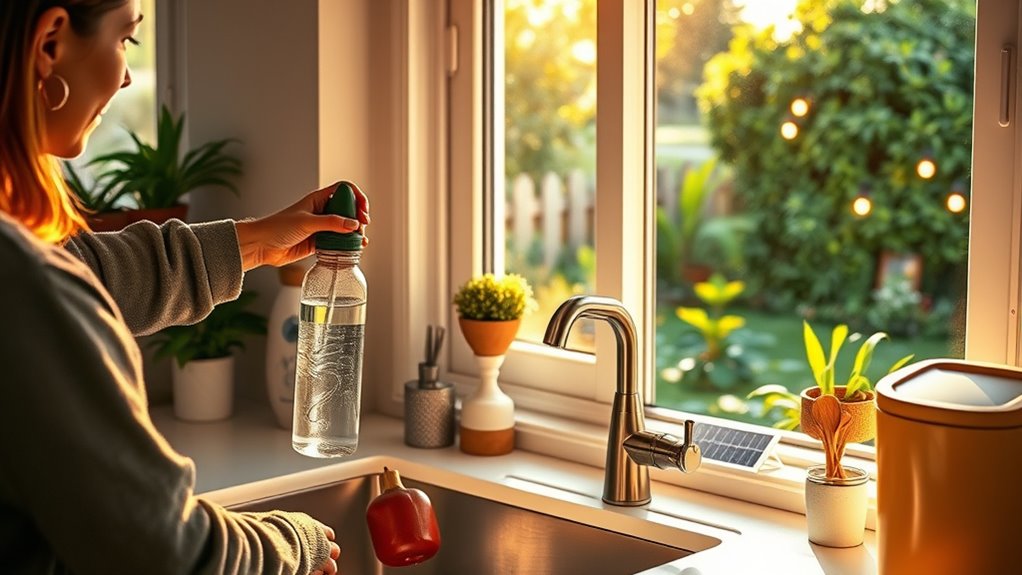By making small, consistent changes like biking, using public transit, or carpooling, you can drastically cut your carbon footprint. Opting for eco-friendly packaging, reducing water usage, and switching to energy-efficient appliances also boost your positive impact. These everyday habits might seem minor, but collectively they create big environmental benefits. Stay with us to discover more simple, effective ways to make your daily routines greener and help protect the planet.
Key Takeaways
- Adopt sustainable commuting options like biking, walking, or carpooling to reduce carbon emissions.
- Use reusable bags, containers, and eco-friendly packaging to minimize waste and support sustainable brands.
- Switch to energy-efficient appliances and bulbs, and conserve water to lower utility consumption.
- Practice mindful purchasing by choosing high-quality, necessary items and reducing single-use plastics.
- Maintain consistent eco-friendly habits daily to create collective environmental impact over time.

Adopting greener daily habits doesn’t require sweeping changes; small, intentional actions can make a significant difference. One of the easiest ways to start is by rethinking how you get around. Sustainable commuting options, like biking, walking, or using public transportation, drastically cut your carbon footprint compared to driving alone. If you do need to drive, consider carpooling or investing in an electric vehicle. These choices don’t just reduce emissions; they also save money over time. Making this shift might seem minor, but when many people adopt sustainable commuting practices, the collective impact is powerful. Plus, you’ll enjoy fresher air and less traffic congestion in your community.
Another simple but impactful habit involves conscious consumption, especially regarding packaging. Opt for products that use eco-friendly packaging—think biodegradable wraps, glass containers, or reusable bags. When shopping, carry your own reusable bags and containers to avoid single-use plastics. Not only does this reduce waste, but it also encourages companies to adopt more sustainable packaging practices. Over time, your choices can influence brands to prioritize eco-friendly materials, creating a ripple effect for broader environmental benefits. Incorporating sustainable packaging into your daily routine can further amplify your positive impact.
Incorporating eco-friendly packaging into your daily routine is straightforward. Look for products labeled as sustainable or biodegradable, and support brands that commit to reducing plastic waste. When ordering takeout or groceries, ask if they offer minimal or recyclable packaging options. You can also repurpose containers and wraps instead of tossing them away, extending their usefulness. These small acts add up, helping decrease landfill waste and lessen pollution. Additionally, choosing packaging made from recyclable materials can enhance the effectiveness of waste management efforts. Being aware of recycling guidelines in your area ensures that your efforts are properly directed and effective.
Beyond transportation and packaging, you can also incorporate other habits that support a greener lifestyle. For example, switching to energy-efficient appliances or bulbs saves energy and lowers utility bills. Reducing water usage by fixing leaks or taking shorter showers conserves precious resources. Being mindful of your consumption habits overall—buying only what you need and choosing quality over quantity—further minimizes your environmental impact. Additionally, understanding the importance of personality traits in your daily decisions can enhance your motivation to sustain these habits.
The key is consistency. Small daily decisions, like choosing a bike over a car or bringing your own reusable coffee cup, may seem insignificant alone. But when practiced regularly, they create a meaningful shift toward sustainability. Over time, these habits can influence your community and inspire others to follow suit. Remember, making eco-conscious choices doesn’t mean sacrificing convenience; it’s about making smarter, more mindful decisions that benefit both the planet and your well-being. By integrating these simple yet effective habits into your routine, you contribute to a healthier, cleaner environment for everyone.
Frequently Asked Questions
How Can I Motivate Others to Adopt Greener Habits?
You can motivate others by using effective motivational strategies, like sharing personal stories and highlighting benefits. Engage your community through events or group challenges that make greener habits fun and collaborative. Lead by example, showing your commitment to sustainability daily. When others see your passion and the positive impact, they’ll feel inspired to join in. Building a supportive environment and celebrating small wins can turn motivation into lasting habits.
What Are Cost-Effective Ways to Start Living Sustainably?
You can start living sustainably cost-effectively by switching to renewable energy options like solar panels or opting for community solar programs. Use eco-friendly packaging by choosing reusable or biodegradable materials for your shopping. These small steps save money over time and reduce your carbon footprint. Additionally, compare energy providers for better rates and support local, sustainable products to make a meaningful impact without breaking the bank.
How Do I Track My Environmental Impact?
Ever wonder if your actions truly make a difference? To track your environmental impact, focus on your carbon footprint and use eco-friendly metrics. You can use online tools and apps that measure your energy use, waste, and transportation emissions. Keep a journal of your habits and review your progress regularly. By staying mindful and adjusting your actions, you turn your efforts into meaningful change, making a real impact on the planet.
Are There Any Apps That Promote Greener Daily Routines?
You’re wondering if there are apps that promote greener routines. Yes, many sustainable lifestyle apps help you track eco-friendly habits and reduce your impact. Some even recommend eco-friendly gadgets to incorporate into your daily life. These apps motivate you to make small changes, like saving water or cutting waste. By using them regularly, you’ll develop eco-conscious habits that benefit both you and the planet, making sustainability a seamless part of your routine.
How Can I Reduce Plastic Waste at Home Effectively?
To reduce plastic waste at home effectively, start by adopting simple recycling tips, such as rinsing containers and sorting plastics properly. Incorporate composting methods for organic waste to minimize trash. Use reusable bags, bottles, and containers instead of single-use plastics. Educate yourself on local recycling rules, and consider repurposing or donating items. Small consistent efforts make a big difference in reducing your plastic footprint daily.
Conclusion
By making small, mindful changes, you’re planting seeds for a greener future. Each habit is like a drop of water nourishing the Earth’s roots, gradually transforming your daily routine into a garden of sustainability. Remember, even the tiniest action can ripple outward, creating waves of positive change. So, keep watering those habits—because together, your efforts can bloom into a vibrant, healthier planet for generations to come.










